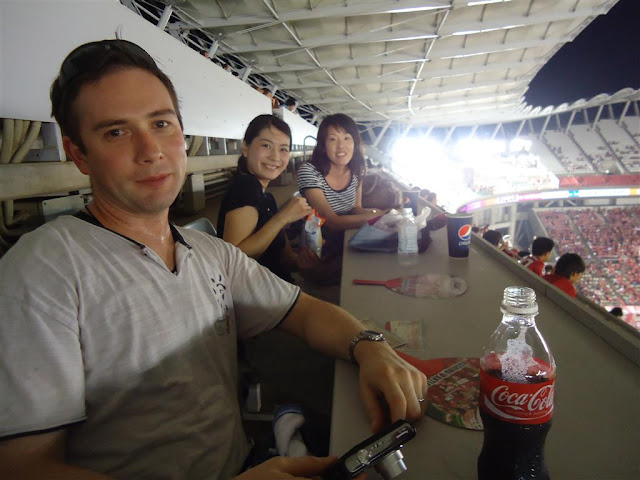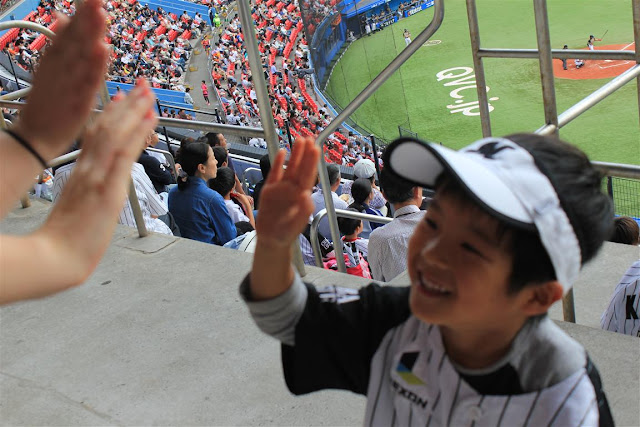This entire month has really flown by! It's nearly the end of October and all the big October events - save for the party at the end, of course - have already occurred. What remains of this month is sure to quickly follow suit, and before you know it we'll be knee-deep in Turkey season! The elementary school trips this month were a lot of fun, and I've got plenty of good pictures and stories to show for it (I'll save those for a little closer to Halloween, though).
Since I've already documented my general day-to-day class schedule, you might wonder what there is to do after work in Choshi. Many ALTs find a lot of happiness in Bukatsu, or after-school activities that keep all the students busy until 6 every day. What's even more insane is that after 6, some go to juku, or cram school, to continue to learn until maybe 8 or 9 PM. Anyway, joining an after-school club seems like a great way to socialize with students and learn Japanese at the same time!
However, I'm currently in the deepest bowels of a rather long project, which quickly became a bet with a carrot dangling on a stick just in front of my face. To answer the question of what I've spent this entire month (and most of last month, save for speech contest time) doing can be summed up in the following pictures:
 |
| This is actually the kanji for Ninja. |
KANJI.
I've been studying kanji, for hours on end, seeking the end of a very long yellow brick road. All my spare time between classes and after work is dedicated to two things: chewing gum, and studying kanji. And I don't chew gum.
Now that we're on the subject, let's have a short little chat about kanji. Kanji, originally called "hanzi" in Chinese, are characters borrowed from the Chinese language that have been adopted into the Japanese language. We say borrowed because sometimes the kanji change in shape or drawing, or they change in pronunciation. Or, they retain pronunciation from Chinese and add additional pronunciations. Indeed, most kanji have several ways of being pronounced, the mechanics of which I'm still a little unsure of.
There are over 2,000 kanji in Japanese that are considered "common" or "in current circulation." What this means is that in order to assume some basic level of fluency, such as reading a newspaper, watching a television show, or playing a video game with text, you need to know those roughly 2,000 kanji to have a decent grasp of what exactly is happening. Indeed, many students of Japanese stumble, trip, and fall when it comes to studying kanji - trying to memorize over 2,000 tiny little shapes filled with intricate stroke orders and multiple meanings can seem like an impossible task. But there is a little consolation.
Of course, there are some very simple kanji, like the kanji for "one" (a single horizontal line) or "two" (two horizontal lines) or "three" (take a guess). Check out this one below, and see if you can guess what it's supposed to be.
 |
| I believe in you. Go for it! |
Note that the above kanji is just one tree. For a grove of trees, simply draw the character twice within the same spacial confine. Drawn three times, it symbolizes a forest full of trees. Pretty easy, huh? Indeed, many kanji seem to come about pictorially -- that is, based up real life objects or scenarios, like these below:
The first one above is the kanji for "bamboo," and the second, for "moon." I can't imagine how many hundreds of thousands of times throughout the centuries these kanji needed to be drawn in order to stray so far from their roots, but hey, I'm not judging.
So you've seen some very easy kanji. But how about some very hard kanji?
Words cannot express my feelings after seeing these kanji.
Please note that the Japanese writing system isn't superfluous in any way: the language only has 46 different basic sounds, so homonyms are beyond plentiful. The difference between four different meanings of the pronunciation "ra" or between the 6 different pronunciations for "a" make kanji a necessity for complete comprehension. Indeed, using kanji, there is little ambiguity, even with a huge number of homonyms. You might say that kanji are therefore a necessary evil. See below for two examples:
 |
| I made a small typo in the above example but I'm too busy studying kanji to fix it. |
As you can see, in the first picture above we have the same sentence written first with kanji, and then without it. Kanji are necessary to be able to read at a competent pace, and to understand word meanings. The second example shows four different words that all have the same pronunciation of "kanji." The kanji themselves denote the specific contextual meaning.
Seriously, how is any student of Japanese language or culture expected to even memorize a few kanji, let alone an entire language's worth? The Japanese grow up and learn kanji throughout every school grade before college, so by the time they graduate high school, they're ready to go out into the world. No wonder Japan has a literacy rate that consistently nears 100%. Can you imagine trying to get around in a world like this?
For reference, the picture above very roughly translates to, "Excluding bicycles, this is a one way street." An alternate pronunciation of this sign says something like "waffles are served over steaming hot engine blocks until four PM daily."
So, imagine stepping off the plane into Narita airport and being bombarded with over 2,000 kanji. Actually, there are way more than that:
| Numbers of characters and reading level |
|---|
| Source | Number | Level |
|---|
| Learnt at shougakkou (小学校) | 1,000 | Schoolchild |
| Jouyou kanji (常用漢字) | 1,945 | Good reader |
JIS level one kanji
Kanken level pre-one | 3,000 | Excellent reader |
JIS level one and two kanji
Kanken level one | 6,000 | Kanji expert |
| Dai Kan-Wa Jiten | 50,000 | Maniac |
I'm not sure if there are really 50,000 kanji. I think this is a joke, but I honestly can't tell. Anyway, imagine stepping off the plane into Japan and trying to do anything: read a label, read a book cover, buy a drink, hail a taxi, find a pay phone, buy a train ticket, etc. It's nearly impossible without some kanji knowledge. Many students resign themselves to the fact that it just cannot be done - our brains have long since passed the point of soaking up knowledge in such amounts. This is why drilling kanji over and over, drawing them thousands of times on paper, just simply doesn't work for adults.
However, a man named James Heisig has invented a wonderful system that allows the student to memorize the drawing and reading of each kanji by using imagination instead of simple visual memory. Here is where the bet comes in. Last month, after being sick and tired of not knowing kanji even though I have a piece of paper at home that says I majored in the language, I sat down on a friend's recommendation and tried this new kanji learning system. Here are before and after shots of my brain:


I've been at it using this system for under two months, and have somehow magically plowed my way through nearly 1,200 kanji, about 2/3 of the recommended amount necessary to live a quality life in Japan. Granted, I've only been studying meanings - the pronunciations will come later. But being able to walk around and read street signs, pamphlets, magazine covers, and gas station pump screens and fully comprehend the meaning of a bunch of complex little squiggles has really improved my quality of life here.
As for the bet, the friend who turned me on to this system (you might remember him as "bigfoot" from the Otaki camping blog post) and I both started our kanji study at the same time. We were both fed up with the traditional method of drilling meaningless shapes into our brain. Whoever finishes first will reap the benefits of a brain full of kanji, and a dinner and drinks on the loser's dime. Pretty good deal, huh?
Back to studying...
















































































